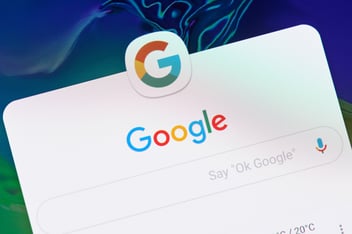In the early 2000s, fledgling search engines like Altavista, Infoseek, Lycos and Google were just starting to determine which search results to show.
One of the first ranking factors was keyword usage. Engines crawled the words on a page, and pages with the most relevant text ranked highest. In their endeavour to generate leads, webmasters realised they could influence rankings by hiding text on a page by making it the same colour as the background, like this. Search engines quickly updated their algorithms to penalise for this.
This back-and-forth still continues today. Search engines dictate what works, webmasters either follow the rules or look for ways to bypass them. The SEO industry arose from this tussling: those who followed the rules wore white hats, the tricksters wore black.
Now that Google has firmly established itself as the dominant search engine, it holds huge sway in curating how the internet looks and feels. By constantly tweaking ranking factors, it is able to influence webmaster behaviour and, so far, the majority of these tweaks aim to improve the quality of the user's online experience.
Trust factors
One of the most significant set of ranking factors introduced by Google in recent years is the Search Quality Guidelines. The importance Google places on search quality is demonstrated by its hiring of human moderators to visit and rate sites, using criteria set out by a hefty rating guide.
Thankfully this guide is public. It’s an absolute monster, weighing in at just over 56,000 words. We’ve sifted through and pulled out the most important trust factors that will help boost your website’s conversions.
- Google’s comic, concisely capturing the need for Search Quality guidelines
Clear purpose of page.
The underlying premise for assessing search quality is purpose of page: "Websites and pages should be created to help users." This is the baseline your site should work from. Make sure each page of your site has a clear purpose, and structure the content accordingly.
Sites where visitors can make financial transactions are held to higher standards, as such pages "could potentially impact the future happiness, health, or financial stability of users”.
- Amazon’s product pages are an excellent example of clear page purpose: every element of the page either informs about the product or encourages the user to buy.
Well-defined page and site structure. “Main content” is a key concept, and refers to content which helps the page achieve its primary purpose(s). Supplementary content does not contribute directly to the purpose, but allows users to navigate around the site and to learn more. Ads are the third type of recognised content, and are not frowned upon by Google unless they are low quality (it would be incredibly hypocritical if they were, considering Google made $95 billion in advertising revenue last year!).
Clearly signposted navigation will boost a site’s rating and enhance user experience. Factors such as effective menus, breadcrumbs to highlight journeys through the site, and logical heading structure are recommended.
- A news article with clearly defined main content (the middle column), segmented navigation in the top nav, secondary content in the top left (topic and author) and bottom right (most viewed articles). Finally, prominent but unimposing ad content in the top right.
Reputation.
Evidence of good and bad reputation is assessed when determining a site’s quality, with the recommendation to integrate testimonials, case studies, awards, press coverage and reviews integrated into your website. These trust factors reassure your visitors that they are dealing with a legitimate and reputable business.
- The case studies on our website showcase projects we’re particularly proud of
Google gives its moderators the advice to “trust the external sources” when “a website says one thing about itself, but reputable external sources disagree”. This suggests that as well as showcasing things that contribute positively to your reputation, you should respond to any negative external reviews in a reasonable and constructive manner.
EAT (expertise, authority and trust).
Google requires "formal expertise" to be demonstrated on sites in certain industries (legal, financial, medical), but is less stringent for others (cooking, fishing, etc). "Everyday expertise" is allowed for the less formal topics, with acknowledgement that the most authoritative writers on some topics can be “ordinary people sharing their life experiences on personal blogs”.
Showcase your team’s expertise and relevant qualifications through team profiles and authored blog content.
- The Moz blog is a key player in the industry, and demonstrates the expertise of Moz's staff and community
User intent and needs met.
Everything included on a webpage should align with user intent or, at the very least, not actively contradict their intent. Imagine yourself as the user of your site, and ensure there are effective user journeys through each page.
In summary: understand user intent, then structure your site and curate your content accordingly. Give correct information and don’t attempt to trick your customers. And avoid these things:
- Unsatisfying amount of main content
- Distracting, disruptive or misleading titles, ads or supplementary content
- Low reputation
- Lack of expertise, authority or trust demonstrated
- Unsatisfying amount of information about the website




